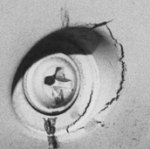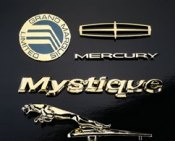New Technology for Automotive Trim
Automotive trim is plated using a different method...
By Paul T. Colarusso
Director PVD Sales, Tanury Industries
Lincoln, Rhode Island
Ten years ago an article on gold-plated Cadillac trim was featured in Products Finishing. At the end of that article I discussed future improvements in durability for automotive trim. Thanks to an exciting new technology, Physical Vapor Deposition (PVD), that future is now!
History. Gold trim has been on vehicles since the 1960's, with dealers driving a steadily increasing demand into the 1980's. In 1987 Cadillac developed the first gold trim program with the goal of providing a durable, consistently engineered finish for its customers. This program was designed to meet specification GM6270M, a stringent set of standards that outlined environmental test requirements for products and simulated five years of wear on the vehicle. GM6270M included:
 |
| A plasma arc, heart of the physical vapor deposition process, is the actual point of deposition. |
- 7 microinches (minimum) of 24 karat gold plate
- 336 hours of neutral salt spray
- 22 hours CASS
- 2500 kJ/m2 Xenon arc weatherometer
- 300 simulated car washes
- 168 hours humidity
- Thermal cycling
- Florida and Arizona exposure
The early 1990's saw a proliferation of portable brush platers used by dealers to gild trim without removing it from the car. Although it is convenient, brush plating has several limitations. During brush plating, the chromium layer is stripped and replaced with varying thicknesses of gold plate. Good adhesion of the gold plate depends upon successfully removing the chrome that prevents the now exposed nickel underplate from readily oxidizing. Since the chromium is stripped only in areas where the wand's tip reaches or can fit, the finisher has increased the risks associated with poor adhesion.
 |
| Gold-plated nameplates and logos. |
The quality of the final finish also depends upon the operator's knowledge, training and experience. And, finally, there is neither an established gold thickness standard nor any method of measurement such as X-ray fluorescence for the brush-plated deposits.
Throughout this time Original Equipment Manufacturers (OEMs) have continued their search for the most reliable finish for premium trim packages for their dealers and customers. PVD technology is the answer.
Process. In the PVD automotive process, cast zinc and molded plastic parts are chromium plated to appropriate automotive specifications. The position of the component on the vehicle and whether it is for interior or exterior use will determine the thickness of the plating layers and the type of testing performed. Typical plating specifications are 200-720 microinches of copper; 600-800 microinches of semi-bright nickel; 200-400 microinches of bright nickel; 7 micro-inches (minimum) of chromium. After the product is chromium plated it is then shipped for a final hardcoating.
At an ISO-certified finishing company such as Tanury Industries in Lincoln, Rhode Island, the parts receive aqueous cleaning, DI water rinses, and spot-free drying, before being loaded into a vacuum chamber. Microetching and material deposition (depending on color and application) along with thickness are precisely controlled via onboard computer. This hardcoating is applied directly onto the existing chromium system, resulting in excellent adhesion with no stripping of the underplate.
Specifications. Although at this time there are no formal automotive durability specifications for PVD coatings, both Ford Motor Company and General Motors have established the following engineering guidelines for acceptable chromium-plated product:
 |
| Laboratory personnel keep the finishing process working properly. |
- 240 hours neutral salt spray
- 44 hours CASS
- 1000 hours/2500kJ/m2 Xenon arc weatherometer
- 1600 hours Carbon arc or Fluorescent UV weatherometer
- 144 hours water immersion
- 240 hours humidity
- Saw grind adhesion (metal parts)
- 5-10 thermal cycles/CASS (Plasticparts)
- Gravelometer (chip resistance)
- Thermal shock, including cold impact
- 1-2 years Florida and Arizona exposure
Advantages. PVD has numerous advantages when compared to gold plating. The process is completely safe environmentally, has no effluent and therefore no requirements for waste treatment. In the case of automotive product, since the underlying chromium layer remains intact, PVD enhances the chromium plating system. The process is also not easily duplicated and requires OEM equipment to reproduce.
The most important advantage is that the PVD process achieves the lustrous look of electroplated gold, has two to three times the wearability, yet is less costly than the traditional 40-50 microinches of gold used during electroplating.
Other Options. PVD can be used to metallize other polymers or materials such as TPU, PVC, Kapton and ceramics, with the unlimited potential of depositing any metal, alloy, compound, or material that can be fabricated into a depositable form. In another automotive application, Tanury Industries and Quality Spraying & Stenciling Company of Providence, have partnered to provide a finish for flexible material that meets all existing exterior environmental requirements.
Case Study. Kennedy Inc., North Kingstown, Rhode Island, is a first-tier supplier of specialty vehicle badging, ornamentation and trim for Ford Motor Company. Presently involved in the QS 9000 certification process, Kennedy Inc. uses PVD capabilities based on excellent color matching to the Ford standard, high production yields, and Tanury's ability to offer certified lab testing for each new program's reliability requirements. According to Steve Kennedy, President, "The PVD process has greatly enhanced the quality and durability of our exterior emblems. As a replacement to gold plating, we can manufacture a product that has both stable color and increased corrosion protection and scratch resistance."
The Future. Looking into a crystal ball, one sees a bright future for PVD. The process offers many exciting prospects for new materials, including alloy target films for both color and performance. Applications for hard-to-plate materials for corrosion, electronic and wear applications, as well as the development of new substrates for coating will one day become reality. Also on the horizon is deposition onto both high- and low-temperature polymers for use in solvent and chemical resistant settings, and an increased use of plastics with metallization that offer cost and weight savings while exhibiting characteristics of the material applied to them.
Research and development into new processes is ongoing, as is equipment evolution for continuous, in-line and batch systems. Some of the latest systems offer cathodic arc and magnetron sputtering, with or without a precious metal option, and all in one machine! The future should also bring apparatus that is less sophisticated yet has maximum flexibility and throughput. These machines will reduce capital costs without sacrificing the quality and consistency of the coatings and the dependability of the equipment.
With such wide-open vistas for potential development, this technology offers an extremely interesting present as well as future. I hope you find it exciting as well and look forward to what the next ten years will bring. See you in 2008! PF